Music of the Mystery Plays
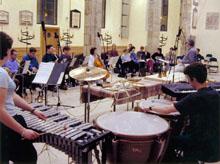
revival, James Brown, is local and we have been able to retrieve his important music score for this archive. Writing for chorus and orchestral brass - enabling the musicians to withstand the vagaries of the English summer - James Brown set a high standard for future productions. An interview with him is among those in the NCEM archive. His picture is on this page of the archive.
In 1984, the music was commissioned from Robert Walker and recorded well in advance of the Plays - creating something of a problem when director Toby Robertson cut the script at the last moment, leaving the music 'hanging' in the air after the actors had left the stage. The re-recording was expensive and uncomfortable - clearly live musicians were a much more flexible option! Some productions have used traditional folk music, eg 'the Seven Joys of Mary' after the Crucifixion, in the Theatre Royal in 1996.
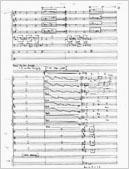 The historic research that accompanied the major revival of the wagon plays in the 1990s encouraged musicologist Richard Rastall to reconstruct various pieces appropriate to the Plays. Richard found one piece by studying a painting of an Angel in the National Gallery in Washington DC. He had to turn the painted music page upside down, transcribe it and then prepare it for performance.
The historic research that accompanied the major revival of the wagon plays in the 1990s encouraged musicologist Richard Rastall to reconstruct various pieces appropriate to the Plays. Richard found one piece by studying a painting of an Angel in the National Gallery in Washington DC. He had to turn the painted music page upside down, transcribe it and then prepare it for performance.The music for the Millennium Mystery Plays performed in York Minster in 2000 was also based on considerable research, but presented in a much more modern idiom by local educationalist and composer Dr Richard Shephard. The two magnificent anthems that
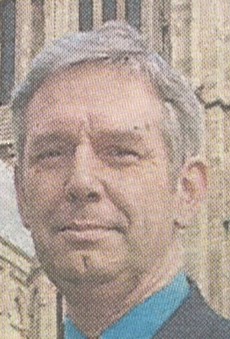 completed each half are still performed in York Minster at special services. In the Minster production in 2016 Dr Shephard again wrote and conducted the music; this page includes an interview with him. He donated a copy of his score to the archive.
completed each half are still performed in York Minster at special services. In the Minster production in 2016 Dr Shephard again wrote and conducted the music; this page includes an interview with him. He donated a copy of his score to the archive.A rich variety of music has contributed to the Mystery Plays' recent heritage. The wagon plays performed by the guilds in recent years, for instance, have often been accompanied by a choir or led in procession by musicians. Below right we see
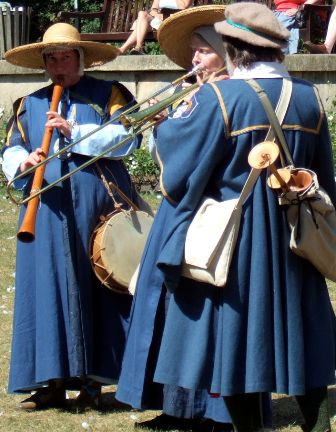 the Leeds Waits in Museum Gardens during the 2006 Wagon Plays.
the Leeds Waits in Museum Gardens during the 2006 Wagon Plays.
Below the York Waits perform among the 2010 Wagon Plays.
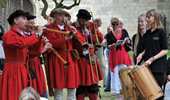

In 2012 the Museum Gardens production had a new score by Chris Madin using a brass band and a 70 strong amateur choir, on right and left of the stage. Below is the choir on the left side.
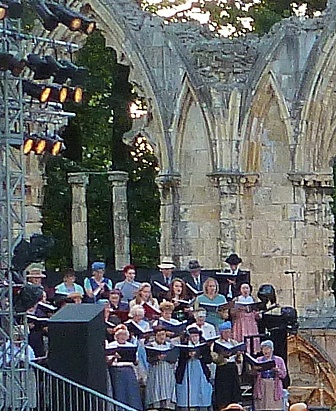
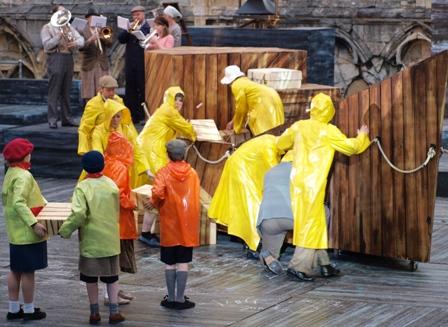
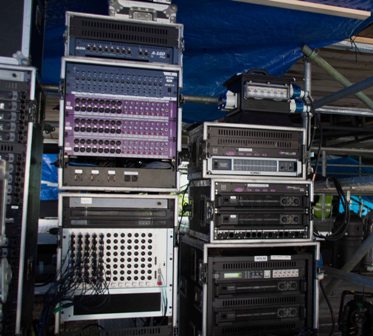
In the photograph at the top of this page music is being recorded in the National Centre for Early Music, an excellent recording studio.

The attached page has a list of the 2012 Choir and Band.
Below right, animals are brought (in boxes) to load onto Noah's Ark whilst behind the Ark a section of the band plays. (Photo: Alan Fleming)

Below left : some of the sound equipment for 2012.
(Nick Ansell)

In the photograph at the top of this page music is being recorded in the National Centre for Early Music, an excellent recording studio.
No doubt future productions of the Plays will continue to be an outlet for powerful and expressive music making.
A list of Musical Directors can be found in the Archive. In 2014 Musical Director Paul Toy arranged for the wagons to be accompanied by ten groups of musicians and Waits: see this page. In other years there have been choirs.
A list of Musical Directors can be found in the Archive. In 2014 Musical Director Paul Toy arranged for the wagons to be accompanied by ten groups of musicians and Waits: see this page. In other years there have been choirs.
Here is an image from the 2022 wagon plays, and at the foot of this page you can hear music from the Last Judgement, thanks to Youtube. 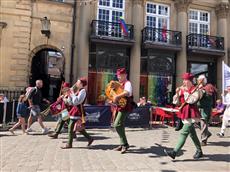

The archive holds The Book of the Music of the 1909 York Historical Pageant, where the Music Master was Tertius Noble.